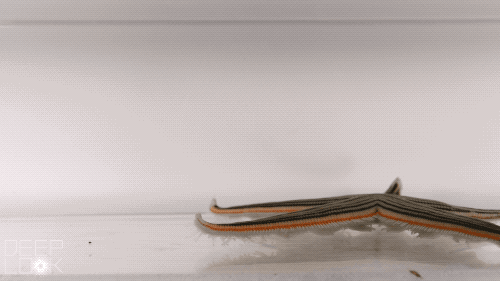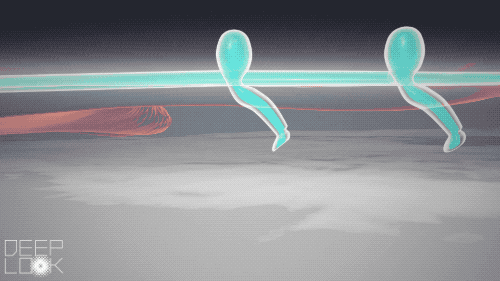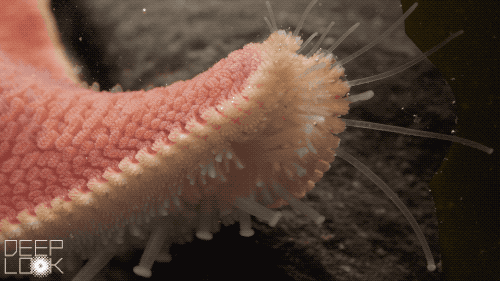On an extended research visit to a friend’s lab in Tokyo, marine biologists Amy Johnson and Olaf Ellers witnessed something they’d never seen before. The starfish in Tatsuo Motokawa’s lab weren’t content slowly gliding across the floor of their tank, they bounced and galloped, zooming around their enclosure.
For one of the most familiar animals in the sea, this was a new behavior, never before described in the scientific literature.
“It was an absolute epiphany,” said Johnson who studies how sea stars move and teaches marine biology along with Ellers at Bowdoin College in Maine. “That moment we first saw them go faster by bouncing completely transformed everything we were planning to do with our research.”
Since then, Johnson and Ellers have worked to change the way we understand these animals, who have successfully made a home on this planet for at least 450 million years.
As part of this mission, the two scientists joined a bicoastal collaboration that may one day lead to robots that could move around like starfish to search shipwrecks, clean oceangoing vessels and explore the seafloor.

What Has Five Arms and Hundreds of Feet?
Starfish, also called sea stars, are one of the most recognizable and familiar animals in the sea. But most people have never seen them do anything more than clamp down on a rock, motionless, as they wait out a low tide.
Starfish are actually voracious predators that scour the seafloors of oceans all around the world searching for prey.
Most sea stars have five arms, though some have more — up to 25 in some species. On the undersides of the arms are hundreds, sometimes thousands, of tiny tube feet called podia.
The long slender tube feet are hollow and full of water, like miniature water balloons. Each tube foot is connected to its own tiny sac called an ampulla, that sits inside the body of the starfish.
When the starfish squeezes the ampulla it extends the tube foot in the direction it wants to go.

A disc at the far end of the tube foot secretes a glue that sticks to whatever surface the starfish is moving across. Then muscles that run along the length of the tube contract, squeezing water back into the ampulla and shortening the tube foot. All those tiny tube feet contracting is what drags the starfish along.

“Normally, they either sit around or they glide very slowly,” Ellers said. “If you want to see them bounce, you have to get them excited about something.”
Johnson and Ellers use tasty mussels to coax the starfish in their lab to gallop. In the wild, starfish might also gallop to flee predators.
The two researchers record videos from different angles of starfish moving across an aquarium in order to keep track of their numerous tube feet. By painstakingly studying the footage and using computer-assisted motion tracking of the tube feet, the pair has been able to identify the two distinct ways that starfish move.
When starfish are in a hurry, their tube feet don’t just move faster. Instead of just elongating and contracting as they do during their regular crawl, the tube feet lengthen and stiffen in the middle of the step.
“It’s like running compared to walking,” said Johnson. “They kind of vault themselves forward.”

When enough tube feet step and stiffen at the same time, it lifts the starfish up slightly as the tube feet vault over themselves. That’s what causes the bounce.
But how do each of the hundreds of tube feet know when it’s their turn to go?
Alright, Who’s in Charge Around Here?
Instead of having a central brain that tells each foot when to move, starfish leave most of the decision-making to the individual feet.
Each tube foot is able to use smell, taste and touch to understand the world around it. The long delicate tube feet at the tips of the arms are particularly sensitive.

It’s up to each one of the tube feet to figure out which way to go and how to get there.
When a group of neighboring tube feet start heading in the same direction they eventually get the entire arm headed in the same direction. Any of the starfish’s arms can take the lead at any time.
“I think tube feet are amazing,” said Eva Kanso, a professor of mechanical engineering at the University of Southern California where she studies the physics of animal movement. “Every single one of them is both a sensor and an actuator that does the work.”
“Being a tube foot, you don’t need to know what other tube feet are doing to decide whether you need to extend or contract or whether you need to attach or detach.”
Kanso had been working with biologist Matt McHenry at UC Irvine to develop a mathematical model of the way starfish control their tube feet, when she learned about Johnson and Ellers’ work.
Kanso’s model matches the movement of the sea stars filmed by Johnson and Ellers.
“Biology has evolved a beautiful way of acting on the environment, and in robotics systems we’re still clumsy in how we do the actuation,” said Kanso, who hopes her model will lead to the development of soft-bodied underwater robots.
“So we teamed up,” Kanso said, “to try to understand how does the nervous system actually control the movements and how does this bounce mode come about.”
“If the sea star needed to know what everything each one of its tube foot is doing, it’s a lot of information to keep track of,” said Kanso. And without a brain, there’s no way for the starfish to keep track. “So it seems that every single one of those tube feet has some autonomy.”
But that only explains the starfish’s crawling gate. How do they manage to time up their tube feet during the bouncing gallop that Johnson and Ellers filmed?
The team of researchers have found the bounce occurs when a few tube feet happen to match up their steps and the feet around them find it easier to move when their neighbors move since they’re all connected to the same flexible starfish. Pretty soon, more tube feet feel the push and pull, and fall in line.
“The pattern emerges from noise,” said Kanso. “It kind of reminds me of how sometimes if people applaud after a show for a long time the claps start to synch up.” No one individual is setting the pace. Researchers call that an emergent pattern.
It’s similar to a classic physics demonstration using analog metronomes. First, place several metronomes on a board and put the board on top of two cylinders. Set each metronome to its own beat. Because the board is on top of the cylinders it has a bit of give while staying rigid. After a short time the metronomes that were once randomly timed start to match each other’s beat. No one metronome is setting the tempo. It’s an emergent pattern just like the bounce of the starfish.
An Afternoon at the Edge of the Sea
So where can you go to see a sea star yourself?
“What’s amazing about tide pools is that they’re unavailable most of the time, so they’re kind of like a little secret that only some people know about,” said Allison Gong, a professor at Cabrillo College who also teaches UC Santa Cruz students about tide pool animals . This episode of Deep Look would not have been possible without her contribution of time and knowledge.
One of Gong’s favorite tide pool denizens are sea stars. “We humans have the bias that the way we do things is the best way to do things. But there is an incredible beauty and elegance in simplicity, which is not appreciated by most people.”
The fact that sea stars haven’t changed their basic body plan for a few hundred million years just means that it’s an outstanding plan.
“So the fact that these animals with no brain live life the way they do, finding food, like finding a place to live, and avoiding being eaten by predators. They do everything we do, but they have different tools to use.”
Gong has a few suggestions for visitors to the tide pools. Always go with someone else. The rocks can be very slippery and you don’t want to be alone if you take a spill. And don’t turn your back on the ocean. Rogue waves can sneak up on an unwary visitor. Also watch where you step and avoid damaging the life that calls the intertidal zone home.
Lastly, Gong recommends taking your time and exercising patience. “Just find a good spot and sit there quietly for fifteen minutes and watch everything that happens. Because when you do, all the little animals get used to your presence and they start doing their thing instead of just hiding, waiting for you to leave.”

